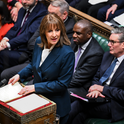Last week I discussed the long-term trends in party support. This week: the short term—what the coming elections can tell us about what is going on right now.
In some ways next week’s contests are a weird group. There are no elections in Scotland, Wales, London or any of the great cities of the Midlands and north of England. Some areas have had their elections postponed ahead of a partial reorganisation of local government. As a result, fewer seats than normal are up for election.
However, for those who are interested in political numbers (and if you are not, why are you reading this?), there will be plenty of signs of where British politics is heading.
The biggest sign will be vote shares, not the tally of seats gained and lost. Not only are there fewer contests than normal; boundary changes mean that seat figures will be even less useful. For many local residents, the elections will make a real difference, with some councils changing hands and others ending up with no overall control. But nationally, the seats figures won’t tell us much. These elections were last fought in 2021, when Britain was emerging from the nightmare of Covid, Boris Johnson’s Conservatives were popular and Keir Starmer’s Labour party had yet to emerge from the shadows of the Corbyn era. Next week, big Tory losses will merely confirm what we already know: voters have not yet forgiven the Conservatives for their record in government.
The estimates for each party’s national vote share will tell us more. Each year two such estimates are published: first by the BBC on the Friday afternoon, the other two days later in the Sunday Times by Colin Rallings and Michael Thrasher of Oxford’s Nuffield Election Centre. The methodologies for the two estimates differ slightly, but essentially they do the same thing: look at the changes in party votes compared with previous years, and extrapolate from these changes to the country as a whole. Despite the reduction in the number of contests this year, there will be enough to paint a reasonably clear picture of the national outcome.
I shall be watching out for two main things. The first is how far the Labour-Conservative establishment has crumbled. Last week I noted that their combined support in the polls has fallen below 50 per cent; a majority now support one of the other, anti-establishment, parties: Green, Reform, the Liberal Democrats and so on. Next week could see this happen for the first time in local elections. Indeed, I should be surprised if it doesn’t. Historically, the anti-establishment parties have done better in local than general elections. The issue is, how far below 50 per cent will the Labour-Tory total fall? My guess is to a combined percentage in the low 40s; but it is possible that the number could go lower. In that case, the trend towards fragmentation might be even greater than I discussed last week.
Secondly, the related question is, what will be the order of the parties in their national vote share? There is a real chance that Reform will come top in votes (though probably not in seats), and the Lib Dems could even come second. If so, Westminster will feel the shockwaves for months to come.
In short, any of four parties could end up in any of the top four places. (I am assuming the Greens will gain ground but still come fifth.) In each case, first place will be a triumph, second place will be a relief, third place a disappointment and fourth place a disaster.
The party with the most to gain next week will be Reform. Not only do they have a chance of topping the national vote; they could gain one of Labour’s safest seats in parliament. Last July, Labour won 53 per cent of the vote in Runcorn & Helsby, with Reform a distant second on 18 per cent, just ahead of the Conservatives’ 16 per cent. Assuming that Labour’s support falls sharply in next week’s byelection and Reform squeezes the Tory vote, the result could be close. This is a contest where precise numbers will matter less than who wins, however narrowly. Think of it as an electoral version of the Micawber principle: victory by 50 votes—result happiness; defeat by 50 votes—result misery.
Reform, then, will have two bites at the electoral cherry next week. They might win the byelection and come first in the national vote. Indeed, they could enjoy a third bite, though one that is likely to receive less attention. Six mayoral elections are taking place. Two areas, in Lincolnshire and Hull & East Yorkshire, are electing mayors for the first time. Reform’s share of the vote last July was more than 20 per cent in both. They must be favourites to win them.
If they do, they might have the Conservatives to thank. In the past, mayoral contests were settled by the “supplementary vote”. People marked their ballot papers with their first and second choice. If no candidate won an overall majority on the first count, then all bar the top two candidates were eliminated. The second choices of those who backed any of the eliminated candidates were then counted.
Johnson’s government scrapped this system and replaced it with first-past-the-post (FPTP). The contest for mayor of Cambridgeshire and Peterborough highlights what this meant last time and what might happen this time.
Four years ago, Labour’s Nik Johnson was elected mayor. He came through on the second count, having been well behind James Palmer, the Conservative candidate, on the first count. Johnson won because he picked up the lion’s share of the second preferences of those who backed Aidan Van de Weyer, the eliminated third place Lib Dem. Most Cambridgeshire voters wanted to defeat the Tories. They got their way.
As next week’s elections are all FPTP, an exact repeat of the 2021 votes would thwart that outcome and result in a Conservative gain from Labour.
I have personal experience of the character of Cambridgeshire politics. More than 30 years ago, when I lived in one of its villages, one of the county’s most senior Labour councillors beseeched me to vote Lib Dem in the elections for the county council, not for my local Labour candidate. They explained: “Labour cannot win the county. Our only chance of helping to run the council is if we beat the Tories in the towns and the Lib Dems beat them in the villages. Then we can govern together. Neither of us can win on our own.”
Four years ago, supplementary voting allowed the clear anti-Conservative majority to get its way in the mayoral election—while tactical voting cost the Tories their majority in the county elections. Next week, a five-way contest under FPTP turns the mayoral contest into a lottery. Goodness knows who will win. It could depend on how many Cambridge villagers split their ticket—voting Labour for mayor but Lib Dem for the county councillors who will be elected at the same time. That is probably the best option for those who want to defeat both the Tories and Reform.
The trouble is, I can’t be certain. In last year’s general election, tactical anti-Conservative voting worked all over England because it was clear almost everywhere how to kick out Rishi Sunak. This time such evidence is lacking, in Cambridgeshire and elsewhere. Which brings us back to Reform. I doubt it could win many two-way contests against any other party. But in a five-way race, the winning post could be well under 30 per cent. More than two-thirds of the voters might be lumbered with a mayor whose politics they actively detest.
By the same token, the relationship between votes and seats might well look odd in many councils as well as mayoral contests. Welcome to the world of fragmented party loyalties. The fallout from next week’s results will shape not just the immediate futures of our political parties. It could also add force to the longer-term debates about the rules of our democracy.













